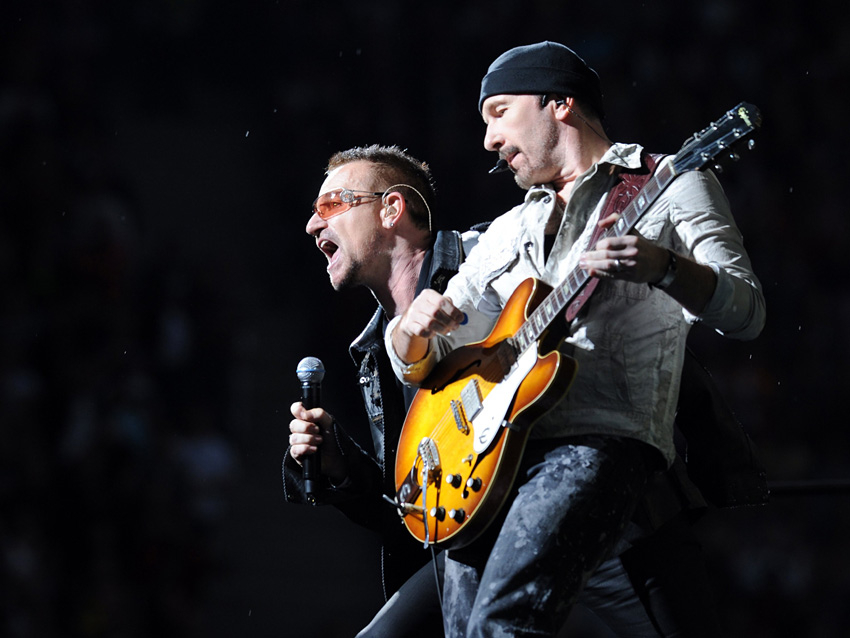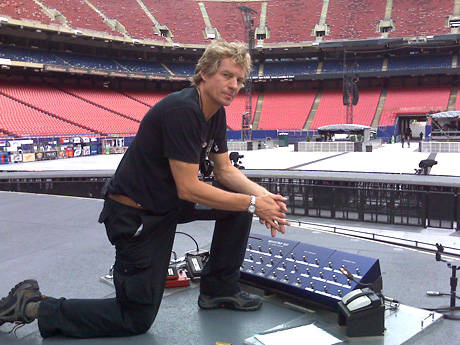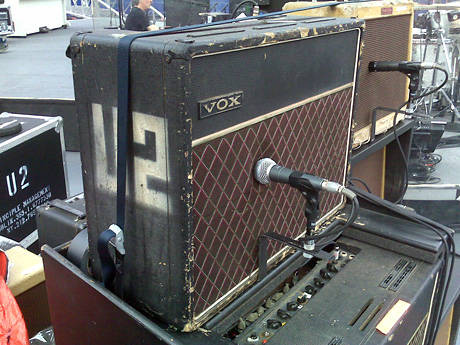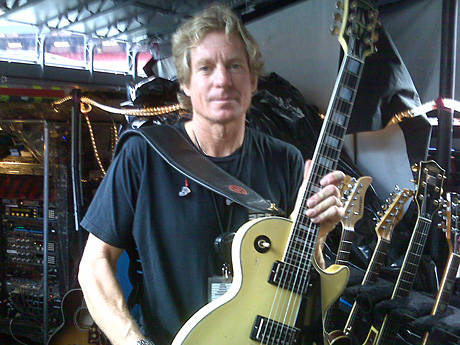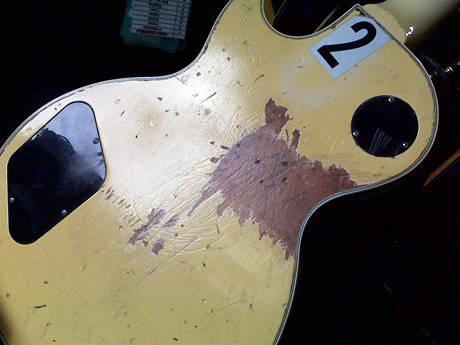How about the '73 black Strat…where is that?"We've got that one. [He picks a black Stratocaster out of its rack, shows it off.] This is the Where The Streets Have No Name Strat. He also plays Bad and Still Haven't Found with it. It's a beautiful guitar. What I really like about it is the way it returns to pitch even with the standard tremolo system. This was actually his second most important guitar after he got the Explorer. Lot of history on this baby.
"The maple neck on this guitar is so bright. This guitar through the AC30 with an old analog delay - that's a magical combination. You give Edge those tools and he'll take you places with them."
Any new guitars that you're dealing with?"Mmmm…There's this '64 Epiphone Casino that he uses on the opening song Breathe; that sounds pretty nice. Then there's a Fernandes Sustainer that he uses on a new version of Ultra-Violet."
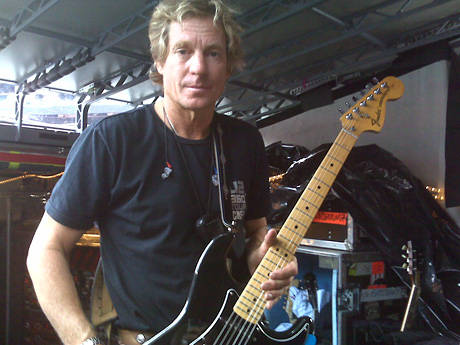 Dallas with Edge's '73 'Where The Streets Have No Name' Stratocaster. Photo: Joe BossoI remember you were trying to get them to play that song again for the longest time.
Dallas with Edge's '73 'Where The Streets Have No Name' Stratocaster. Photo: Joe BossoI remember you were trying to get them to play that song again for the longest time.[laughs] "Yes, I love that song! For years I've been asking them to do it again. Of course I don't know if I can claim credit for them putting it back in the set or whether they just figured it was time. But they are, and the Fernandes sounds incredible on it."
Edge started going wireless on this tour, didn't he?"He did. He wanted to move around more and work the stage - it's that kind of show. But as of three nights ago, we went back to wires; we're plugged in again. The reason is pretty obvious: the signal is direct and true. Wireless, it was fine. But there's no comparison."
How are the Death By Audio pedals working out?"Oh, they're great! We're using the Supersonic Fuzz Gun and the Harmonic Transformer. This guy, Ben Curtis - great guy - he makes these different distortion pedals and he turned us on to them.
"At first, I didn't know if Edge was going to be able to use them. They sounded a bit like white noise to me - white noise with some parameters. But Edge heard them and he was like, 'No, no, there's something there.' And he started hooking them up to his echoes, and viola! he started making music.
"The Fuzz Gun is on No Line On The Horizon, that big intro sound. It's on Ultra-Violet, too - it's fantastic. The guy is always looking for something new that can create music, and he'll tinker with a pedal or a device for days until he can make it do something he wants."
In addition to working with The Edge on tour, you're also with him in the studio - you're a full-time employee."That's right. Edge and I have a great relationship and his trust in me is very gratifying, so yes, I do work with the band in the studio. Any time guitars and amps need set up for recording, I'm there - wherever that is!" [laughs]
On the new album, were there any times that you helped Edge out with a guitar sound, if there was something he was stuck on?"There was an instance on the new record where something like that occurred. It's usually Bono who will say to me, 'I'm having trouble on such-and-such a song, Dallas. I need the right attitude, I need some inspiration. Before Edge gets here, can you work on some things, come up with a guitar or effects?' And of course, it's extremely flattering when he does that.
"There was a song called Stand Up, that… the guys were in a bit of a rut. It was good, but they were frustrated. They didn't feel it was going to that next level. We were in Olympic Studios. Bono was sitting on the couch writing lyrics. Steve Lillywhite came in and said, 'There's no juice to the song. The middle-eight isn't happening. There's no inspirational sound to it. I think we should just cut it from the record and move on.' Danny Lanois and Brian Eno were in total agreement.
"Now, I'm thinking, The Edge is the best guitar player in the world. I know he can make this song work. So Bono said to me, 'Dallas, this song can fly. Can you go into the studio and think of something?'
"So I went in and I turned on three distortion pedals and an analog echo. I plugged in the Explorer and I came up with this really offensive distortion sound. But then I did something: I turned the volume on the guitar off, hit a chord and then I cranked the volume knob."
You worked it like a volume pedal."Yeah! It created this incredible siren-like sound. All of a sudden, every face in the studio lit up and Bono was like, 'Edge, get in there! That's it!' Edge raced in, took the guitar from me, and at that point it was all in his hands; he found the right note patterns, the right places to play, and he totally turned the song around and made it a winner."
till, it wouldn't have happened without you.[He shrugs modestly] "Ah, you get lucky sometimes."
The Definitive guide to The Edge's live equipmentSpecial thanks to Dallas for providing us with the following, comprehensive list of The Edge's live setup on the 360° Tour. From guitars and amps right down to strings, slides and straps, it's all detailed here for the first time:
The Edge's under-stage effects rack:1. Furman Pro Rack Power (110V)
2. KORG SDD Digital Delay (VOX) (240V)
3. Korg SDD 3000 Digital Delay (240V)
4. Line 6 DM4 Pro(A) Custom made rack device
5. Line 6 DM4 Pro (B) Custom made rack device
6. TC 2290 Digital Delay ("A") (240V )
7. TC 2290 Digital Delay "(B") (240V)
8. Line 6 Pod Pro(110V) (A)
9. Line 6 Pod Pro (110V) (B)
10. Korg A3 Multi Effects (240V)
11. TC 2290 Digital Delay (C)
12. TC 2290 Digital Delay (D)
9b. KORG A3 Rack Multi Effects Unit (110V) (B)
13. Furman Pro Rack Power #2
14. Eventide H3000 Harmonizer
15. Lexicon PCM80 Digital Effects Processor
16. Lexicon PCM70 Digital Effects Pro
17. Custom Audio Elec AMS Interface
18. AMS SDMX Digital Delay (A)
19. AMS SDMX Digit Delay (B)
20. Custom Audio Elec Remote Wah
21. Custom Audio Elec Dual Stereo Mixer
22. Rocktron Bradshaw DVC Pedal VCA
23. Custom Audio Amp Selector
24.Custom Audio Patch Point (110V)
25. Skrydstrup MR9 Loop System (A)
26. Skrydstrup MR9 Loop System (B)
27. Skrydstrup MR9 Loop System (C)
28. Skyrdstrup System Interface
29. Electrix "Filter Factory"
The Edge's outboard effects pedals:30. Durham Electronics "SexDrive" Dist pedal
31. BOSS CS-3 Compressor Sustain pedal
32. DIGITECH "Synth Wah" Pedal
33. Death By Audio "HARMONIC TRANSFORMER" Dist Pedal
34. Death By Audio "FUZZ GUN"
35. Electro Harmonix " POG" pedal
36. Line6 DM4 Distortion pedal
37. Death By Audio "Soundwave Breakdown"
38. Boss Noise Suppressor NS-2
39. Boss EQ GE-7 pedal
40. Skrydstrup "Bufferooster" pedal
41. Boss FET FA-1 Amplifier
42. Drive Breaker Distortion pedal
The Edge's main onstage pedalboard:Skrydstrup SC1 + SC1 Extensions + Extension Plus Controller + Dunlop Crybaby Rack Wah Controller, Digitech WH1 Whammy Pedal,
Peterson V-SAM Tuner
Dallas' offstage pedalboard:Skrydstrup SC1 + SC1 Extension+ Extension Plus
The Edge's onstage amplifiers:1964 VOX AC30TB Grey Panel
1970's VOX AC30TB Grey Panel
1972 VOX AC30TB Grey Panel
1957 Fender Tweed Deluxe
1958 Fender Tweed Deluxe
1959 Fender Tweed Deluxe
1956 Fender Harvard
The Edge's offstage amplifiers:1974 VOX AC30TB Red Panel
2008 Marshall 50Watt 1987X Amp Head
1966 4 X 12" Closed Back Cabinet w/Celestion Vintage Speakers (Mick Ralphs owned)
The Edge's wireless guitar system:(8) SHURE U4RS Dual Receivers
(13) SHURE UR1-J5 Beltpacks (Individually Set/dedicated gain Structures to Each Show Guitar)
"Rab Tronix" (6) Way Selector Box
The Edge's tour guitars:Gibson 2005 "Music Rising" Les Paul
Gibson 2006 "Music Rising" Les Paul
Gibson 1976 Natural Explorer
Gibson 1976 Natural Explorer (spare)
Epiphone 1962 Sunburst Casino
Epiphone 1964 Sunburst Casino w/Bigsby
Fernandes 2003 Native Sustain Guitar
Fernandes 2009 Retro Rocket Sustain Guitar
Fender 1975 Brown Custom Telecaster
Fender 1966 Cream Telecaster w/Maple Neck
Fender 1969 Cream Telecaster w/Maple Neck
Gretsch 1963 Chet Atkins Walnut Country Gentleman
Gretsch 1968 Chet Atkins Walnut Country Gentleman
Gretsch 2009 Chet Atkins Walnut Country Gentleman w/Piezo Fishman Acoustic System
Gretsch 1959 Sunburst 6101 Country Club
Gibson 1966 Cherry SG Les Paul Standard
Gibson 1965 Pelham Blue SG Les Paul Standard
Fender 1968 Tobacco Stratocaster w/Rosewood Neck
Fender 1973 Cream Stratocaster w/Maple Neck
Fender 1975 BlondeTelecaster w/Rosewood Neck
Fender 1974 Black Telecaster w/Maple Neck
Gibson 1973 Cream Les Paul Custom
Gibson 2008 Cream Replicated Les Paul
Fender 1973 Black Stratocaster w/Maple Neck
Fender 1976 Black Stratocaster w/Maple Neck
Fender 1974 Black Stratocaster w/Maple Neck
Rickenbacker 1966 Fireglo 330-12
Rickenbacker 1966 Fireglo 330-12(Spare)
Rickenbacker 1967 Maple Rickenbacker 330-12
Rickenbacker 1967 Maple Rickenbacker 330-12(Spare)
Rickenbacker 1968 Black 325
Gibson 2008 Sunburst SJ-200 Acoustic/Electric
Gibson 2006 Blonde "Pete Townshend" SJ-200 Acoustic/Electric
Gibson 2008 Blonde SJ-200 Acoustic/Electric
Gibson 2005 Sunburst J-45 Acoustic Electric
Martin 1972 Natural D12-28 Acoustic/Electric
Martin 2009 Natural D12-28 Acoustic/Electric
Epiphone 1966 Sunburst Texan Acoustic/Electric
Fender 1994 Arctic White Telecaster(Japanese)
Line 6 2005 Red/Black "Variax" Modelling Guitar
Gretsch 2009 Black G6136 Falcon w/Fishman Piezo Acoustic System
Fender 2009 Sunburst American Vintage '52 Telecaster w/Piezo Acoustic System
MOOG 2009 MG-001 Tobacco Sunburst Sustain Guitar
The Edge's guitar strings:D'Addario EXL110 XL Reg Lite .10-.46
D'Addario EXL115 XL Blues Jazz .11-.49
D'Addario EXL116 XL Medium Top Heavy .11-.52
D'Addario EXL 140 Light Top/Heavy Bottom .10-.52
D'Addario EXL 150 Light Elec 12 String .10-.46
D'Addario Phosphor Bronze Wound EJ15 Extra Light .10-.47
D'Addario Phosphor Bronze Wound EJ26 Custom Light .11-.52
Martin MSP 400 Bronze .10-.47
Martin MSP 4050 Bronze Custom Light .11-.52
Martin M500 Extra Light Acoustic Bronze 12 String .10-.47
Ernie Ball P02233 12 String Electric .009-.046
The Edge's additional instruments and show accessories:YAMAHA CP80 Electric Piano + Roland JC 120 Combo Amplifier
EBOW hand held Sustain Chrome and Plastic Electronic Bow
D'andrea medium Nylon Picks
Herdim German Medium Nylon Picks
Datum Machining/Dallas Schoo Custom Machined Finger Brass Slides
Dunlop Brass Full Slides
Levy Leather Guitar Straps
Dallas Schoo Uses Peterson VS-R Strobo Rack Tuner, Peterson V-Sam Tuner, Peterson VS-Strobo Flip, Boss TU12 Guitar Tuner
musicradar


















